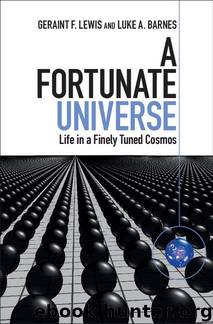A Fortunate Universe: Life in a Finely Tuned Cosmos by Geraint F. Lewis & Luke A. Barnes

Author:Geraint F. Lewis & Luke A. Barnes [Lewis, Geraint F.]
Language: eng
Format: epub, azw3
Publisher: Cambridge University Press
Published: 2016-09-29T16:00:00+00:00
Universal Symmetry
There are other, more radical changes we can make to the laws of physics. We need to talk about symmetry.
Like quantum, symmetry is a term that sounds like it belongs in a discussion of home decorating, feng shui and crystals. In fact, symmetries are extremely important to modern physics. They are both practical and profound, bringing simplicity and beauty to our equations. To many physicists, the search for ultimate laws of physics simply is a search for the deepest symmetry.12 And, importantly, from symmetry we get conservation laws.
Here’s how it works: wherever a symmetry can be found in the structure of the Universe, you will find an associated conserved quantity that doesn’t change with time. To understand this, let’s look at some examples.
From high-school physics you may remember a host of conserved quantities, things like energy, momentum and electric charge. The total amount of these things remains the same over all time; energy, for example, cannot be created or destroyed, but only converted from one form to another. Other quantities are not conserved. In classical physics, while the total amount of energy is conserved, kinetic energy alone isn’t; cars turn petrol into motion, and then motion into heat as the brakes are applied. Magnetic fields, temperatures, gravitational acceleration and many other physical quantities are not conserved either. Conserved quantities are much beloved by physicists because they need only be calculated once. Whatever the messy predicament in which your system finds itself, the conserved quantities will not have changed.
We have the brilliant mathematician Emmy Noether to thank for linking symmetries with conservation laws. Noether is an unsung hero of modern science, an intelligent woman at a time when academia was completely dominated by men. ‘In the judgment of the most competent living mathematicians, Fräulein Noether was the most significant creative mathematical genius thus far produced since the higher education of women began,’ noted Einstein in her New York Times obituary.
Here is a simple example of Noether’s insight. Imagine you do a physics experiment in your lab, and you get a particular result. You don’t expect to get different results if you move all your lab equipment one metre to the left, because you assume the laws of physics over there are the same as here. Sounds obvious, even trite, but using a particularly powerful approach to classical physics known as Lagrangian mechanics, this translational symmetry implies the conservation of momentum.
Similarly, any physics experiment done today gives the same result as an identical experiment conducted yesterday, or tomorrow. This time symmetry, thanks to Noether, implies the conservation of energy.
But there is more to physical things than where and when they are, and thus there are more symmetries to be found, though they will not be as easily visualized. For example, a symmetry hidden within the quantum mechanical wave function results in the conservation of electric charge.
The link between symmetries in nature and the existence of conserved quantities often comes as a surprise to students of physics. But once you realize how
Download
A Fortunate Universe: Life in a Finely Tuned Cosmos by Geraint F. Lewis & Luke A. Barnes.azw3
This site does not store any files on its server. We only index and link to content provided by other sites. Please contact the content providers to delete copyright contents if any and email us, we'll remove relevant links or contents immediately.
The Complete Stick Figure Physics Tutorials by Allen Sarah(7291)
Secrets of Antigravity Propulsion: Tesla, UFOs, and Classified Aerospace Technology by Ph.D. Paul A. Laviolette(5299)
Thing Explainer by Randall Munroe(3864)
The River of Consciousness by Oliver Sacks(3519)
The Order of Time by Carlo Rovelli(3131)
How To by Randall Munroe(3016)
A Brief History of Time by Stephen Hawking(2947)
I Live in the Future & Here's How It Works by Nick Bilton(2922)
The Great Unknown by Marcus du Sautoy(2632)
What If?: Serious Scientific Answers to Absurd Hypothetical Questions by Randall Munroe(2626)
Midnight in Chernobyl by Adam Higginbotham(2473)
Blockchain: Ultimate Step By Step Guide To Understanding Blockchain Technology, Bitcoin Creation, and the future of Money (Novice to Expert) by Keizer Söze(2430)
Networks: An Introduction by Newman Mark(2341)
The Meaning of it All by Richard Feynman(2288)
Easy Electronics by Charles Platt(2271)
The Tao of Physics by Fritjof Capra(2221)
Midnight in Chernobyl: The Untold Story of the World's Greatest Nuclear Disaster by Adam Higginbotham(2166)
When by Daniel H Pink(2075)
Introducing Relativity by Bruce Bassett(2064)
